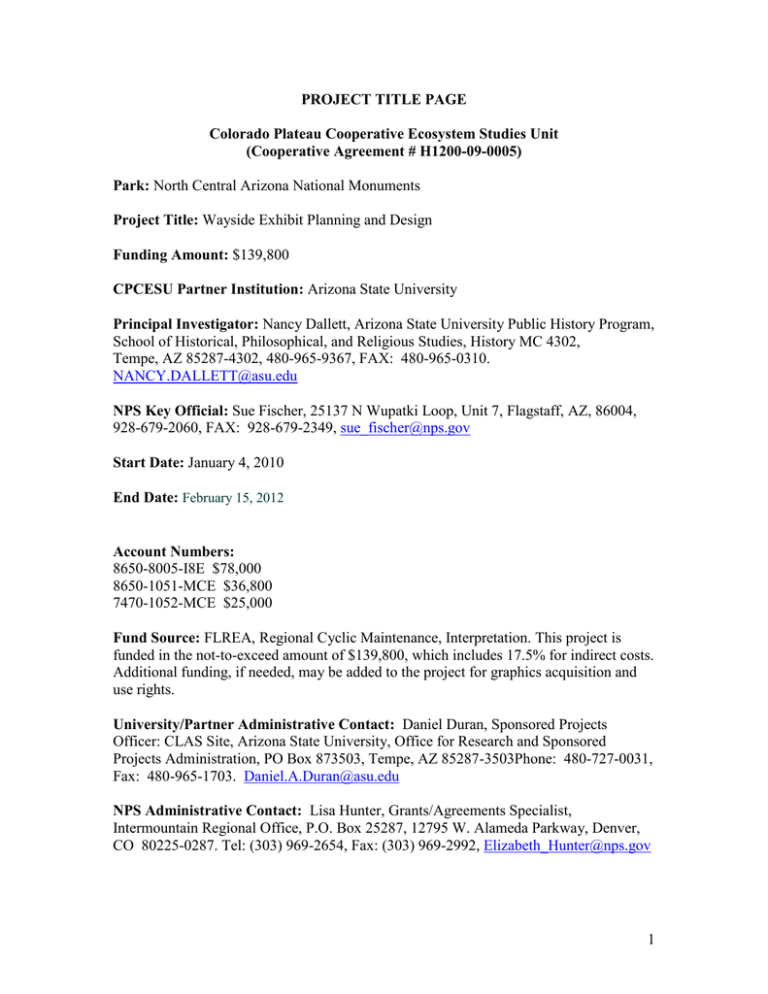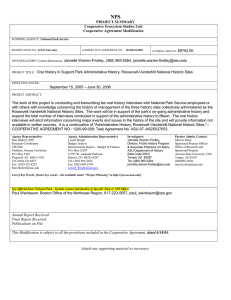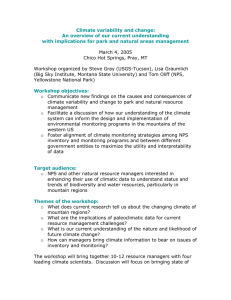ASU-057
advertisement

PROJECT TITLE PAGE Colorado Plateau Cooperative Ecosystem Studies Unit (Cooperative Agreement # H1200-09-0005) Park: North Central Arizona National Monuments Project Title: Wayside Exhibit Planning and Design Funding Amount: $139,800 CPCESU Partner Institution: Arizona State University Principal Investigator: Nancy Dallett, Arizona State University Public History Program, School of Historical, Philosophical, and Religious Studies, History MC 4302, Tempe, AZ 85287-4302, 480-965-9367, FAX: 480-965-0310. NANCY.DALLETT@asu.edu NPS Key Official: Sue Fischer, 25137 N Wupatki Loop, Unit 7, Flagstaff, AZ, 86004, 928-679-2060, FAX: 928-679-2349, sue_fischer@nps.gov Start Date: January 4, 2010 End Date: February 15, 2012 Account Numbers: 8650-8005-I8E $78,000 8650-1051-MCE $36,800 7470-1052-MCE $25,000 Fund Source: FLREA, Regional Cyclic Maintenance, Interpretation. This project is funded in the not-to-exceed amount of $139,800, which includes 17.5% for indirect costs. Additional funding, if needed, may be added to the project for graphics acquisition and use rights. University/Partner Administrative Contact: Daniel Duran, Sponsored Projects Officer: CLAS Site, Arizona State University, Office for Research and Sponsored Projects Administration, PO Box 873503, Tempe, AZ 85287-3503Phone: 480-727-0031, Fax: 480-965-1703. Daniel.A.Duran@asu.edu NPS Administrative Contact: Lisa Hunter, Grants/Agreements Specialist, Intermountain Regional Office, P.O. Box 25287, 12795 W. Alameda Parkway, Denver, CO 80225-0287. Tel: (303) 969-2654, Fax: (303) 969-2992, Elizabeth_Hunter@nps.gov 1 NPS CPCESU Research Coordinator: Dr. Judy Bischoff, Research Coordinator, CPCESU, Northern Arizona University, P.O. Box 5765, Flagstaff, AZ 86011-5765. Tel: (928) 523-6638, Fax: (928) 523-8223, Judy_Bischoff@nps.gov PROJECT SCHEDULE: Project Start Date – January 4, 2010 Site Visits – Feb 1 to 15, 2010 Wayside Proposals (NPS) and thumbnail sketches completed (ASU) – March 30, 2010 Draft Concept Plans and Text – July 30, 2010 Progress Report – Aug 15, 2010 NPS comments/edit due (including Tribal consultation) – Sept 15, 2010 Final Production Files – Dec 1, 2010 Errors and corrections during production, project closeout – Feb to May 31, 2011 Final Report – Aug 15, 2011 Project End Date – February 15, 2012 Invoices Payable Monthly for Costs Incurred Product: The Principal Investigator will prepare a brief report abstract suitable for public distribution and two hard copies and an electronic version (in PDF file format) of the final report (the abstract, accompanied by PDFs of each of the panels will serve as proxy for a final report) and mail all to the NPS Research Coordinator, CPCESU, NAU, P.O. Box 5765, Flagstaff, AZ 86011-5765. INVOICES ARE PAYABLE ONLY IF THE REPORTS AND/OR PRODUCTS HAVE BEEN RECEIVED AND APPROVED BY THE NPS KEY OFFICIAL. 10% OF PROJECT FUNDS WILL BE WITHHELD UNTIL AFTER ACCEPTANCE OF THE FINAL REPORT. NO INVOICES SMALLER THAN $200 WILL BE PAID EXCEPT FOR THE LAST INVOICE TO CLOSE THE PROJECT ACCOUNT. SCOPE OF WORK: This proposal serves to establish specific responsibilities pursuant to Cooperative Agreement No. H1200-09-0005. Under the conditions of this agreement, the National Park Service (hereinafter referred to as NPS, or the Service) and Arizona State University (hereinafter referred to as ASU) propose a partnership to plan, design, and develop final production-ready files for approximately 100 wayside exhibits for the North Central Arizona National Monuments (NCANM). This collaborative effort will combine ASU’s technical assistance in research, writing, and design with NPS plans for improved interpretation and educational opportunities within the monuments. This work is consistent with the objectives of the Colorado Plateau Cooperative Ecosystem Studies Unit (CPCESU) in that it provides an opportunity for research into the archaeological, historical, geological, and biological resources of five national monuments—Montezuma Castle (MOCA), Montezuma Well (MOWE), Tuzigoot (TUZI), Sunset Crater Volcano (SUCR), and Wupatki (WUPA)—and the chance to develop practical skills in wayside exhibit writing and design. The project will engage students and faculty in learning the significance of the monuments, the values inherent in 2 the resources, and the NPS’s approach to interpretation. The final products will offer multiple opportunities for all park visitors to make a connection to park resources, potentially increasing the public’s appreciation, understanding, and enjoyment of these special places. Background The national monuments of north central Arizona include Montezuma Castle, Montezuma Well, and Tuzigoot in the Verde Valley, a significant riparian area in a biological transition zone between the pine uplands of the Mogollon Rim and the lowlands of the Sonoran desert. To the north, on the Rim, are Walnut Canyon, Sunset Crater Volcano, and Wupatki national monuments located in the vicinity of Flagstaff. These parks provide opportunities for visitors to learn about the indigenous peoples who have occupied this region for thousands of years. The human histories are linked among these places, as is the significant geology and ecology protected in these parks. Providing visitors opportunities to connect with park resources is a priority. Wayside exhibits provide the most direct interpretation of park features. Located outdoors along primary park trails and overlooks, waysides provide site-specific interpretation by connecting visitors with the significant meaning and values of the resources at hand. They serve people who otherwise may not be presented with information about the park and the NPS. They also help insure that visitors have a safe experience and visit responsibly. In all of these parks, the vast majority of current waysides were installed in the late 1980s. Most are etched anodized aluminum signs and are outdated, obsolete, and degraded; some are culturally insensitive. The interpretive content needs an updated, creative approach, with new graphic materials and multiple perspectives to more effectively convey the meanings of the resources. American Indian views are also important to the park stories. By updating and upgrading the depth of the interpretation and the wayside design, visitors will be provided with a stronger message and a greater opportunity to connect with park resources. The tasks in this project involve five of the six monuments: Montezuma Castle (MOCA), Montezuma Well (MOWE), Tuzigoot (TUZI), Sunset Crater Volcano (SUCR), and Wupatki (WUPA). The parks are separated by a maximum of 125 miles; driving time between them ranges from 30 minutes to 2.5 hours. Project Standards and General Task Responsibilities New waysides will use the most current NPS standard grids, version 2.6 (available on the Harpers Ferry Center (HFC) web site: www.nps.gov/hfc) and open type fonts (available on HFC web site), and will be designed to conform to NPS “Wayside Exhibits Typographic Standards” (also on the HFC web site) and NPS Identity Standards (http://www.graphics.nps.gov). The proposed wayside exhibits are: 3 Park Low Profile 36”x24” Plant Ids 6”x12” TUZI MOCA MOWE SUCR WUPA 21 (on 2 trails) 15 17 5 (at 3 different locations) 5 14 14 13 Total 63 41** Total Waysides 104 panels ** Includes 14 duplicate panels among the 3 parks; ethnobotany/identification panels will be developed for a total of 27 different plant species. ASU will develop one wayside plan from six NPS-provided wayside proposals: the Montezuma Castle Trail; Montezuma Well Trail; Tuzigoot Pueblo and Tavasci Marsh Trails; Sunset Crater Lenox Trail, Bonito Flow Overlook, and Cinder Hills Overlook; Citadel and Nalakihu Pueblo Trail; and Ethnobotany and Plant Identification Waysides for MOCA, MOWE, and TUZI. ASU will make site visits to each of the parks and prepare thumbnail sketches of the proposed exhibits, will be responsible for writing, editing and design work, graphic acquisition, new illustrations, high resolution scanning, and final production ready files. NPS will be responsible for preparing the wayside proposals, which form the basis for the new waysides; providing reference materials and assisting in locating graphic material; editing, review, and approval of concept and final plans; conducting tribal consultation and incorporating comments into plans; preparing NEPA/106 compliance documents. NPS will provide project oversight, and as needed, assistance with archival and collections access, synthesis of results of park-specific research and ethnographic studies, and content development. Final disposition of property purchased with project funds: After project completion, the laptop will become the property of the partner. The camera will be returned to the NPS Key Official for use by park staff. Tasks 1. Site Visits During site visits ASU will survey the specified areas within each park with the park planning team for an explanation and understanding of previously completed wayside proposals done by the parks’ exhibit specialist. These will be provided to ASU prior to the visits. On site, the team will discuss the dominant park features and characteristics, and review each proposed wayside location and related content. From these discussions and using the 4 provided wayside proposals, ASU will prepare thumbnail sketches for each panel. This is the first attempt to take purpose, graphics, and ideas and shape them into a visual presentation and is used to test ideas with the planning team and for documenting decisions. A refined pencil rough will be provided to the park for inclusion in the Wayside Exhibit Proposals as the distillation of these first ideas and discussions. This task will involve: a) Developing a schedule for site visits. (ASU and NPS) b) Becoming familiar with the park and parks’ history through review of the park websites, legislation, planning documents, wayside proposals, other interpretive media, and materials provided by the NPS. (ASU) c) Review of an initial selection of graphics in hand or based on knowledge of what is available to inform the on-site discussion. (ASU and NPS). Review of park graphic collections and sources for any additional graphics located off-site. Gathering reference material for proposed illustrations and maps. (ASU and NPS) d) Development of pencil roughs on-site to facilitate a discussion that results in a visual representation of the interpretive ideas. (ASU) e) Establishing connections to local historical societies, museums or other relevant partners. (ASU) f) Providing park with final sketches for inclusion in the wayside exhibit proposals. (ASU) 2. Wayside Proposals This task will involve: a) Making changes to proposals as needed and incorporating thumbnail sketches; submitting final copies to ASU. (NPS) 3. Primary Research This task will involve: a) Compiling and digesting specific subject-matter information for use in the creation of interpretive text. (ASU and NPS) b) Locating and identifying potential graphics to include custom artwork, illustrations, maps, and photographs. Review selections, cost, license terms, and time to acquire and finalize selections. (ASU and NPS) 5 c) Acquiring finalized graphics, making high-resolution scans, and editing digital images as needed. (ASU) 4. Wayside Exhibit Plan The Wayside Exhibit Plan is a series of graphic layouts that show how the interpretive elements will work together. This task will involve: a) Development of digital graphic layout files using NPS standard grids, tools, and standards. (ASU) The following specifications direct the development of the files: Colors: standard color systems for the printing industry including CMYK, RGB, and the Pantone Color Matching system will be used. Sizes: 36” x 24” and 6” x 12” grids are provided on HFC web site. True trim sizes are 35 7/8” x 23 7/8” and 5 7/8” x 11 7/8” respectively. Software: Adobe InDesign CS 3.0.1, Adobe Photoshop CS 8.0 or higher, and Adobe Illustrator 10.0 or higher is needed. Virus protection software is required for files being created for transmission to NPS. Type fonts: Use of the Adobe Frutiger face and NPSRawlinson is required. ASU will need a license from the Adobe Type library for Frutiger light, light italic, roman, roman italic, bold, bold italic, black, black italic, and ultra black. NPSRawlinson will be provided by the NPS with guidelines for use. b) Writing interpretive text. (ASU) NPS will review and approve draft text as it is completed for each park site or trail. ASU and NPS will work together to edit final text. c) Manage graphic resources. (ASU) An image management data system will be needed to track and manage the graphics, site photos, and other visual components of each wayside panel. Final image data provide to NPS shall include all pertinent information for each graphic—source of original, owner, copyright data, photographer or artist, medium, size of reproducible needed, and whether the image is an original or edited version. d) Preparing wayside plan. (ASU) NPS will review and approve the Wayside Exhibit plan. 5. Wayside Exhibit Production-Ready Package 6 The production-ready package will consist of the production-ready digital layout files, high resolution graphic files, and color proofs. This task will involve: a) Creating a production-ready package, based on the approved Wayside Exhibit Plan, from which wayside exhibits can be fabricated. (ASU with assistance from NPS as needed and noted) The following specifications direct the development and handling of the files: File naming: NPS will oversee file naming to be consistent with standards. Color management: ASU will need color-managed workflow to ensure color accuracy and consistency. This includes calibrated monitors using the D50 standard and profiled proofing devices using ICC profiles. An RGB workflow shall be adopted for all raster graphics including all Photoshop tiffs, and PSD files. Adobe 1998 RGB profile will be used and embedded in all RGB images. CMYK will be used for all vector graphics, including maps, diagrams, and symbols. b) Developing production-ready files. (ASU) NPS will direct ASU as needed in properly prepared files and proofs. A unique InDesign file will be created for each exhibit, at full scale in high-resolution which is not less than 200 dpi at actual output size, and delivered via Macintosh/PC formatted CD, DVD, or ftp site. c) If needed, ASU will provide file corrections during fabrication. Service Substantial Involvement NPS staff will be substantially involved coordinating project. Continual oversight, advice, and consultation with faculty and students will occur in all phases of the project. NPS Staff will provide the necessary support, approvals, and legal compliance necessary for ASU to achieve timely completion of all work associated with this project. The Service will provide access to NPS collections as necessary. The Service will provide support by providing personnel in the form of Sue Fischer, Exhibits Specialist, and other NPS specialists as needed. The Service will provide review of writing style, graphics selection, interpretive content, and exhibit design to insure they adhere to NPS standards, policies, and concerns. Products: A. Site visit notes and hand drawn thumbnails for each of the wayside exhibits. B. Draft Concept Design Plan and Text a) Draft InDesign layout files, of draft text and draft layouts. 7 b) Revised PDF’s with updated tag information, all revisions from previous submission are to be included. c) Three 11”x17” color copies of Concept Design Plans including all revisions from previous submission. C. Final Production Files a) Three 11”x17” color copies of the final digital Production Files, three sets of CD’s/DVD’s with all InDesign exhibit layouts, high resolution scanned graphics, production notes, and Final Graphics Resource Package. Schedule Site visits will be completed by Feb 15, 2010. Wayside Proposals will be completed by March 30, 2010. Draft Concept Plans and Text will be submitted by July 30, 2010. After submission, NPS will have until Sept 15 to make comments and suggestions for revisions (including comments received from Tribal consultation). Final Production Files will be submitted by Dec 1, 2010. A final report will be submitted by Aug 15, 2011. All products will be submitted to the park exhibit specialist (NPS Key Official). Final payment will be made before the Project End Date of August 15, 2011. Product: The Principal Investigator will prepare a brief report abstract suitable for public distribution and two hard copies and an electronic version (in PDF file format) of the final report (the abstract, accompanied by PDFs of each of the panels will serve as proxy for a final report) and mail all to the NPS Research Coordinator, CPCESU, NAU, P.O. Box 5765, Flagstaff, AZ 86011-5765. Budget See attached file The total project budget is $139,800, and may not be adequate to accomplish all the desired tasks. The cost of graphics acquisition, for example, may end up being substantially higher than estimated. Funding will be tracked by ASU as the project progresses and periodic budget updates will be done. Costs and tasks will be periodically reviewed and tasks and responsibilities adjusted if needed. The NPS may eliminate some tasks if needed to stay within budget, or may add additional funds to the project. NPS will accept full responsibility for any delays in the project schedule due to funding shortfall. 8


